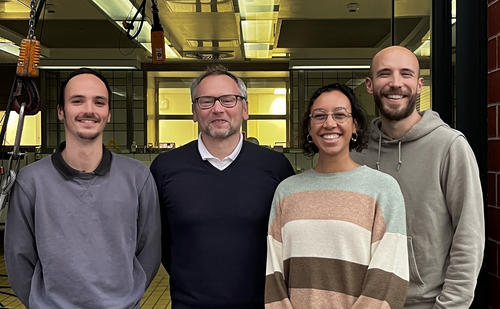November 2024 – Chloé Puget
Chloé Puget
AG Klopffleisch (v.l.n.r): Malte Baeblich, Prof. Robert Klopfleisch, Chloé Puget und Thomas Conrad
Chloé Puget, Jonathan Ganz, Julian Ostermaier, Thomas Conrad, Eda Parlak, Christof A. Bertram, Matti Kiupel, Katharina Breininger, Marc Aubreville und Robert Klopfleisch
Veterinary Pathology, October 18, 2024. https://doi.org/10.1177/03009858241286806. Impact Factor: 2,3.
Numerous prognostic factors are currently assessed histologically and immunohistochemically in canine mast cell tumors (MCTs) to evaluate clinical behavior. In addition, polymerase chain reaction (PCR) is often performed to detect internal tandem duplication (ITD) mutations in exon 11 of the c-KIT gene (c-KIT-11-ITD) to predict the therapeutic response to tyrosine kinase inhibitors. This project aimed at training deep learning models (DLMs) to identify MCTs with c-KIT-11-ITD solely based on morphology. Hematoxylin and eosin (HE) stained slides of 368 cutaneous, subcutaneous, and mucocutaneous MCTs (195 with ITD and 173 without) were stained consecutively in 2 different laboratories and scanned with 3 different slide scanners. This resulted in 6 data sets (stain-scanner variations representing diagnostic institutions) of whole-slide images. DLMs were trained with single and mixed data sets and their performances were assessed under stain-scanner variations (domain shifts). The DLM correctly classified HE slides according to their c-KIT-11-ITD status in up to 87% of cases with a 0.90 sensitivity and a 0.83 specificity. A relevant performance drop could be observed when the stain-scanner combination of training and test data set differed. Multi-institutional data sets improved the average accuracy but did not reach the maximum accuracy of algorithms trained and tested on the same stain-scanner variant (ie, intra-institutional). In summary, DLM-based morphological examination can predict c-KIT-11-ITD with high accuracy in canine MCTs in HE slides. However, staining protocol and scanner type influence accuracy. Larger data sets of scans from different laboratories and scanners may lead to more robust DLMs to identify c-KIT mutations in HE slides.

